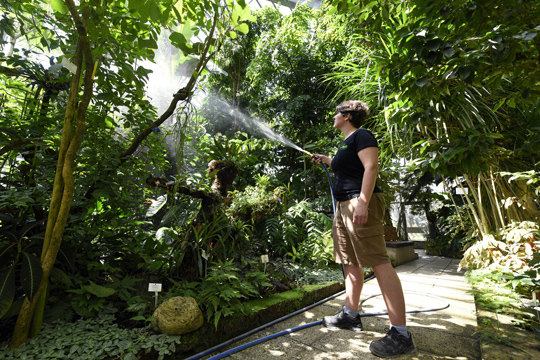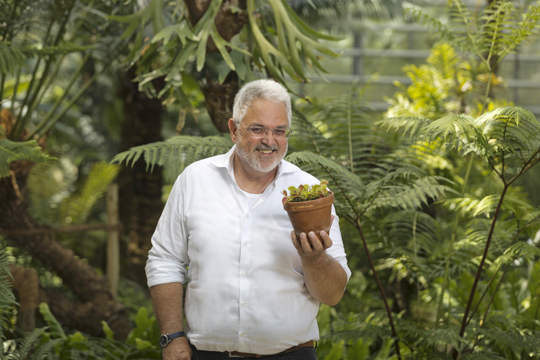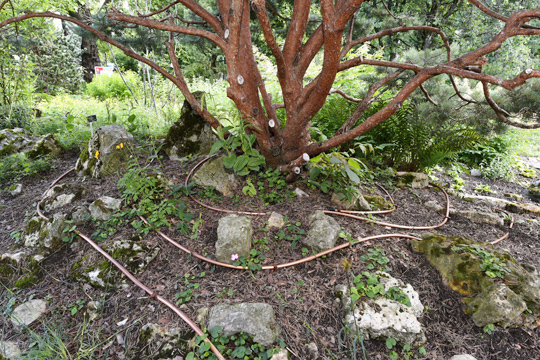A green oasis celebrates its birthday
The University of Freiburg Botanical Gardens turn 400 - and celebrate four centuries of change
The Botanical Gardens moved to new land in Schänzlestrasse in the Herdern district in 1912, where it remains today. Photo: Thomas Kunz

A freshening shower and the day can begin: Regina Müller of the Gardens team sprays the plants in the tropical greenhouses to raise the humidity. Photo: Thomas Kunz
“The first gardens had very little in common with today's Botanical Gardens,” says Professor Thomas Speck, who has been the director since 2002. The first Hortus Medicus was created primarily for training doctors, in line with the belief that there was a herb to cure every disease.
The Freiburg Botanical Gardens are Germany’s fifth-oldest such institution at a university. They showcase research and teaching, but are also a place of quiet, relaxation and education for the public. The Gardens at their current location have always focused on plant geography. “The Gardens sought to meet the higher expectations of citizens, who could increasingly afford to travel to other countries,” says Speck. The plant family trees were developed long before they could be determined using systematic molecular analysis. According to what we know now, some of the trees were placed into the wrong families, but others are correct. A display board illustrates the changes.

Bionics at the Botanical Gardens: One of the thing Thomas Speck works on is the complex mechanism of a venus fly trap using artificial materials.
Photo: Jürgen Gocke
Surviving on the Noah’s Ark principle
Bionics is example of the close connection between the Gardens and research. A nature walk in the Gardens features 15 information boards about the results of basic research in the field. One of the aspects discussed is the self-cleaning or “lotus” effect, observed on the marsh plant of the same name. Speck says one of the Gardens’ key functions is what’s known as the Noah’s Ark principle, aimed at preserving endangered species. For example, the Gardens have a small vineyard containing various grape varieties and traditional companions such as wild tulips and onion grass; these bulbs are also given to winegrowers to grow wild. There have been occasions on which visitors have misunderstood the task of species conservation and have released aquarium animals - such as small piranhas - in the Gardens without asking permission. And it did not stop at small fish - the head gardener once received an inexplicable electric shock while working on one of the ponds; a meter-long electric eel was the culprit. The eel spent the rest of its life in Stuttgart Zoo.
It all began in Neuburg
When it comes to exhibitions such as “Researchers, Collectors, Plant Hunters,” the Gardens are in close contact with around 100 other botanical gardens in Germany. “We also offer 100 to 150 guided tours for school classes, companies and visitor groups every year,” says Speck.
The first Gardens were laid out in 1620 in the district of Neuburg, probably on the site of today's Stadtgarten. The exact location is not known. The Thirty Years' War and Vauban's fortifications around 1677 put an end to it. According to a chronicle, remnants of the garden were “used for culinary purposes.” The second Gardens were set out in 1677 along today's Kronenstraße on the left bank of the Dreisam after a 90-year break. Despite a stronger botanical orientation towards the “Clavis Systematis Sexualis” thought out by the natural scientist Carl von Linné, these Gardens were - like their predecessor - mainly a medical teaching garden. One problem: a false understanding of Linné's system based on pistils and stamens led the Catholic Church to put Linnés research on its index of prohibited works.
Margraves and new greenhouses
The Gardens thrived under the botanical interest of its directors while Freiburg was under Austrian rule. Starting in 1805, under the rule of the Margraves of Baden, it changed significantly. “With financial support, greenhouses were newly built and existing ones extended from 1827 onwards,” Speck says. “That was the start of the scientific botanical orientation.” One innovation was the national and international exchange of seeds among the botanical gardens, which began in 1830 - at that time with about 3,300 species, today with 6,000. The need for space in the growing city led to the construction of new streets and drove the Gardens first into the Institutsviertel in 1879 and, as building increased there around 1912, to a specially-purchased plot of land on Schänzlestrasse, the Gardens’ current location.

Well-equipped to combat climate change: A clever drip irrigation system supplies water to trees sensitive to dry conditions. Photo: Thomas Kunz
The Gardens in the age of Coronavirus
This period also saw the final separation from the discipline of Medicine upon the founding of a mathematics and science faculty. The Botanical Gardens were destroyed during the bombing of Freiburg in 1944, but were subsequently reconstructed and expanded. “The Gardens are well-placed to face new challenges such as climate change,” says Speck. Drought-sensitive trees like the Bald Cypress were the first to benefit from a sophisticated drip irrigation system. “More plants will follow,” says Speck. Early on, the team began setting up a database for the exchange of plant seeds. A digital QR system is also being planned to provide visitors with as much information as possible about individual plants via their phones.
A virtual tour of the garden and a series of events had been planned for the 400th anniversary celebrations, but the Coronavirus crisis put paid to those plans. Some of the activities will be held later, others will be cancelled outright. Due to the pandemic, the Botanical Gardens had to close its gates to comply with the regulations that apply to all faculties and institutes. “It really is surreal,” says Thomas Speck. “The other day I was sitting on a bench in the empty Gardens during my lunch break and though how sad it was that students and researchers cannot work here right now.” He says it is regrettable that people are missing how beautifully everything is blooming at this time of year. “It makes my heart bleed,” Speck says. But he remains optimistic and he and his team are currently working on concepts to reopen this green paradise. And even without the Coronavirus, many challenges await the Botanical Gardens. “We will need a lot of energy for future tasks, but we are looking forward to them.”
Eva Opitz
University of Freiburg Botanical Gardens


